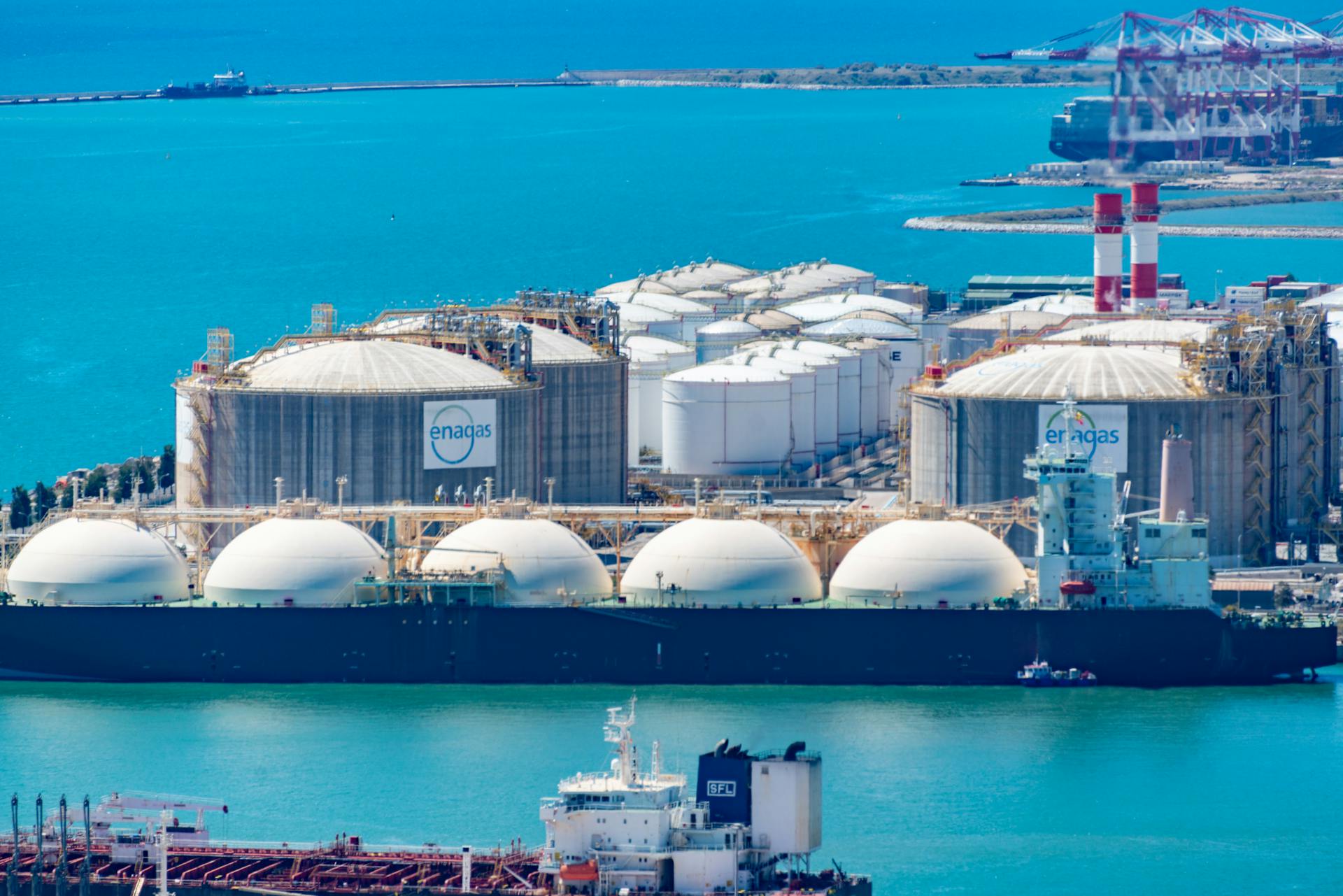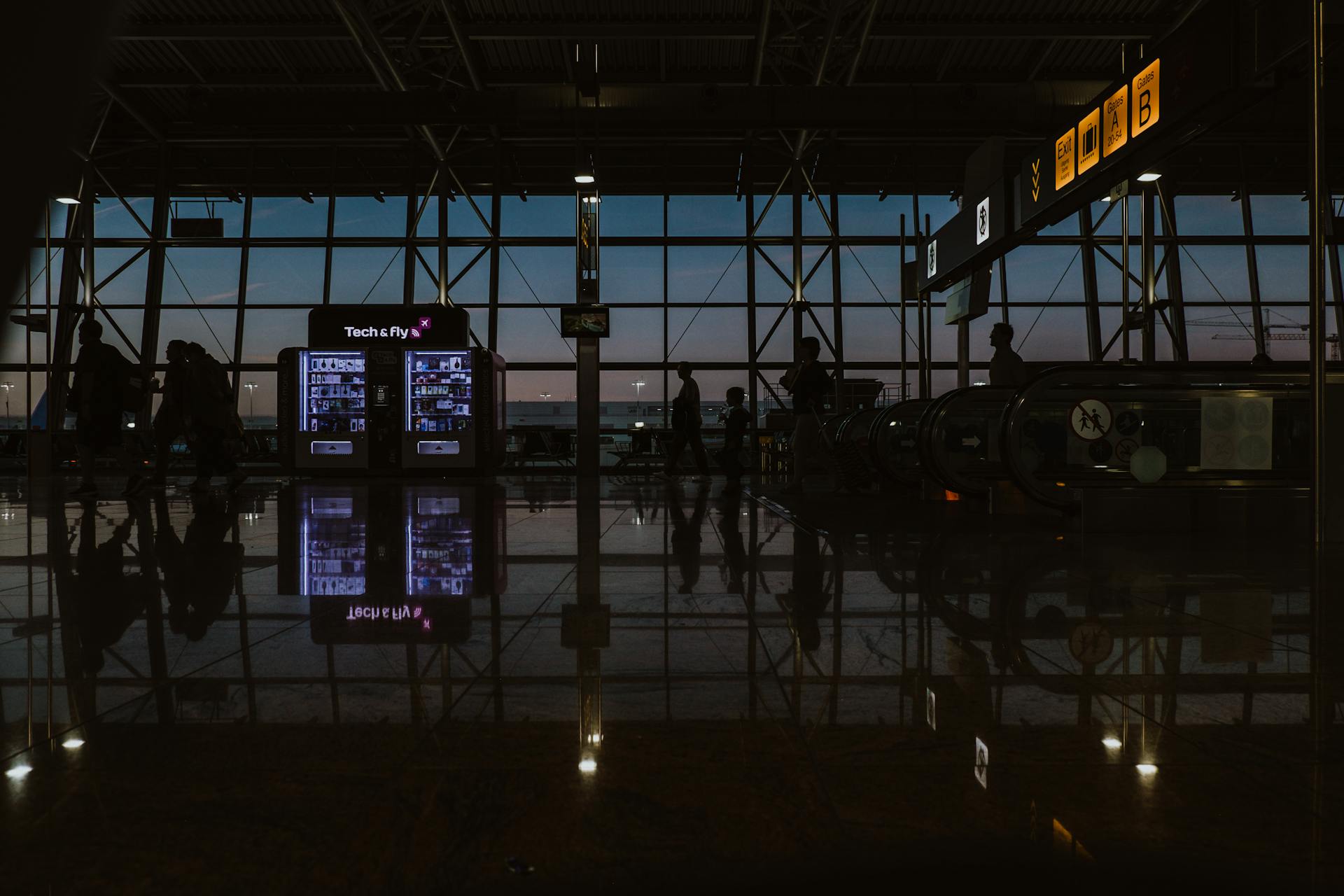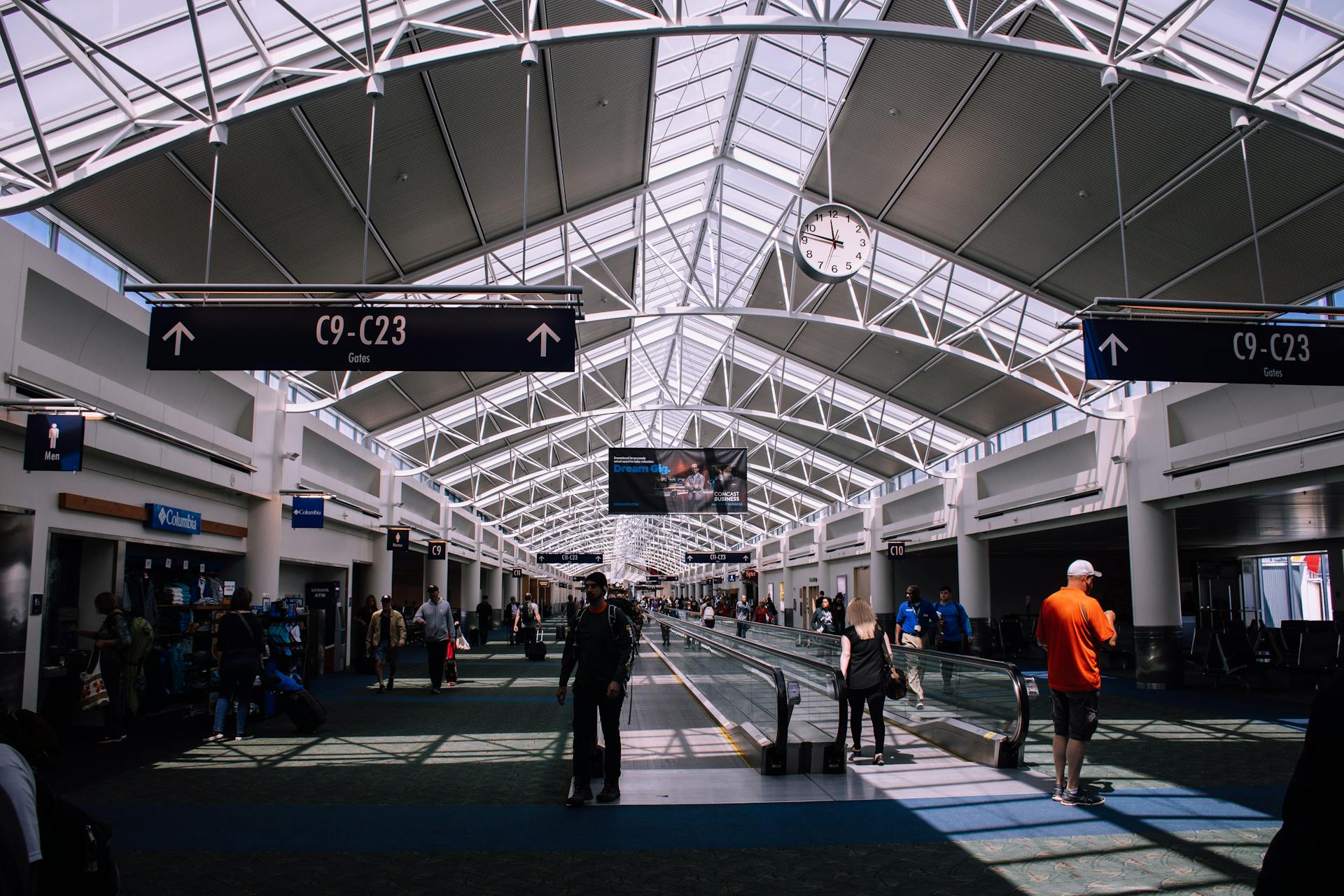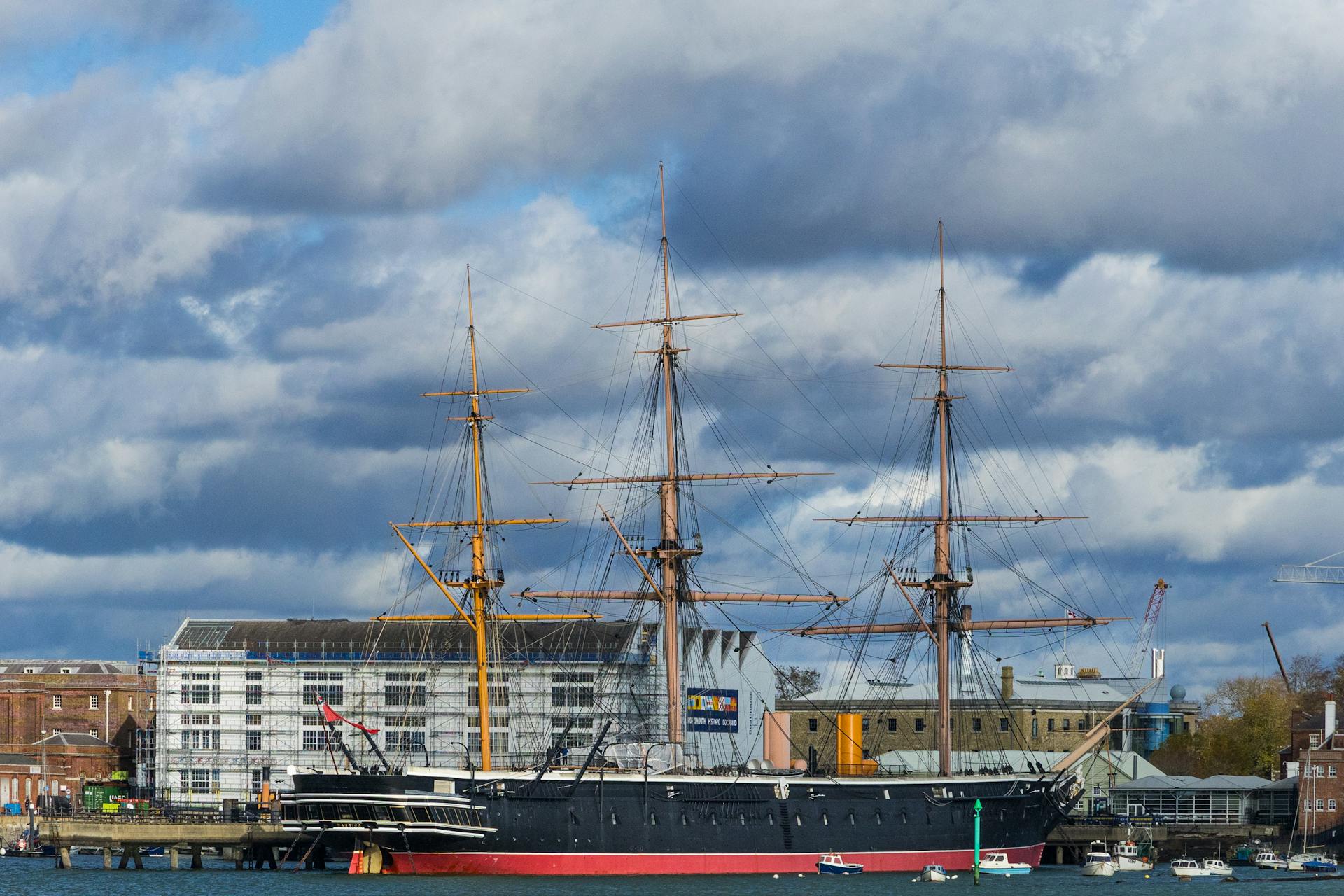
Liquefied natural gas (LNG) terminal locations are scattered across the globe, with many situated in coastal areas where they can be easily accessed by ships.
The United States has several major LNG terminals, including the Cove Point terminal in Maryland and the Sabine Pass terminal in Texas.
The Freeport terminal in Texas is another significant LNG terminal in the US.
These terminals are strategically located to facilitate the export of LNG to countries with high demand for this energy source.
LNG Terminal Overview
The LNG terminal at the Port of Tacoma is a significant facility that provides a cleaner fuel alternative to local transportation companies, including TOTE Maritime Alaska vessels.
It can also supply natural gas to residential and commercial customers, ensuring dependable service during the coldest days of the year.
The terminal is operated by Puget Sound Energy and offers a vital service to the community.
The facility's location at the Port of Tacoma allows for efficient transportation of the liquefied natural gas to its customers.
LNG Terminal Operations
LNG Terminal Operations are a complex process that requires specialized equipment and materials to handle the extreme cold temperatures of the liquid natural gas.
LNG is kept at about −162 °C (−260 °F) to maintain it in a liquid state. Special metals like aluminium alloys with 3 to 5 percent magnesium and high nickel steels containing 9 per cent nickel are used for this low-temperature cryogenic service where metal is in contact with LNG.
The loading/unloading arms and pipework are insulated to prevent heat gain from the air to minimize the vaporization of LNG. This is crucial to maintain the liquid state of the gas.
Types
There are two main types of liquefied natural gas (LNG) terminals: liquefaction terminals and regasification terminals. Liquefaction terminals are used for the export of LNG, while regasification terminals are used for the import of LNG.
LNG terminals can be designed to handle both export and import operations, making them a versatile option for countries with both LNG exports and imports.
A floating storage and regasification unit (FSRU) is a type of LNG terminal that is moored near a port. As of January 2014, FSRUs were operating in several countries around the world, including Brazil, Argentina, and the UAE.
Here are the different types of LNG terminals:
- Liquefaction terminals for the export of LNG
- Regasification terminals for the import of LNG
- Combined terminals that handle both export and import operations
LNG Terminal Operations
LNG Terminal Operations involve the transfer of LNG between ship and shore, which requires special metals to prevent brittleness at extremely low temperatures.
LNG is kept at about −162 °C (−260 °F) to maintain it in a liquid state, and the loading/unloading arms and pipework are insulated to prevent heat gain from the air.
Terminal facilities include jetties and piers with articulated loading/unloading arms for transferring LNG between ship and shore. It also includes the piping used to transport LNG between the loading arms and the storage and processing facilities at the terminal.
Tankers being loaded with LNG displace the vapour volume in their tanks, and this gas is routed to boil-off or gas recovery storage tanks, where it may be compressed and fed into the local gas network.
Conventional carbon steels are brittle at the temperature required for LNG, so special materials like aluminium alloys with 3 to 5 percent magnesium and high nickel steels containing 9 per cent nickel are used.
Regasification is the process of converting LNG from a liquid to a gaseous state, which requires significant quantities of heat energy to supply the enthalpy of vaporization of LNG.
A series of heat exchangers are used to regasify the LNG, which may include submerged combustion vaporisers, or an intermediate fluid exchanger using propane or other fluids, or the use of waste heat from a nearby plant such as a power station.
Final heating of the gas may use air or seawater heat exchangers, and the outgoing gas may need to be analysed and enriched or diluted to meet the quality specification of the gas transmission system.
Propane may be added to enrich the gas, and nitrogen to ballast or dilute it, before it is metered and dosed with a stenching or odorizing agent prior to distribution into a high-pressure transmission system.
Existing and Proposed Terminals
There are several existing and proposed liquefied natural gas (LNG) terminals around the world. In China, the Jingbian Terminal in Yulin, Shaanxi Province, is one such terminal, which is expected to be completed by December 2009. It's operated by China Natural Gas.
In operation in Chile are the GNL Mejillones and GNL Quintero terminals. Another terminal under construction is the GNL Penco terminal.
In Europe, several terminals are planned or under construction, including the Stade LNG Terminal, Brunsbüttel LNG Terminal, and Wilhelmshaven LNG terminal in Germany. The Alexandroupolis INGS terminal in Greece is operational, with a storage capacity of 170,000 m3 and a regasification capacity of 6,100,000,000 m3 per year.
Here's a list of some of the proposed and existing terminals in India:
Existing Terminals
Puget Sound Energy operates a liquefied natural gas (LNG) facility at the Port of Tacoma that provides a cleaner fuel alternative to local transportation companies.
This facility is a valuable resource for companies like TOTE Maritime Alaska, which relies on it to power its vessels.
The LNG facility can also provide natural gas reserves to residential and commercial customers, ensuring dependable service on the coldest days of the year.
Proposed Terminals
Jingbian Terminal in Yulin, Shaanxi Province, China is planned to be completed by December 2009.
Three liquefaction terminals are already in operation: GNL Mejillones, GNL Quintero, and GNL Penco.
The Stade LNG Terminal is a proposed regasification terminal.
The Brunsbüttel LNG Terminal is also a proposed regasification terminal, operated by a joint venture consisting of Gasunie, Oiltanking, and Vopak.
The Wilhelmshaven LNG terminal is another proposed regasification terminal.
The Alexandroupolis INGS terminal is planned with a total storage capacity of 170,000 m3 and a regasification capacity of 6,100,000,000 m3 per year.
Here are some additional proposed regasification terminals:
- Crete LNG Terminal, planned
- Kavala LNG Terminal, planned
- Pipavav LNG Terminal (APM Terminals)
- Mangalore LNG Terminal Ltd
- Paradip LNG Terminal (GAIL)-4.8 mt/year
- Kakinada LNG Terminal owned by GAIL, GDF SUEZ, and Shell. 5 mt/year.
- Kakinada LNG Terminal owned by VGS Cavallo, 3.6 mt/year.
- Kakinada LNG Terminal owned by H-Energy (GMR), 1.75 mt/year.
- Vizag LNG Terminal owned by Petronet LNG, 10 mt/year.
- Chhara LNG Terminal (HPLNG) – 5 mmtpa (https://www.hplng.in/index) under construction
- Dhamra LNG Terminal (DLTPL, Adani-Total)
Kuwait
Kuwait has a total of 10 operational terminals, with the largest being the Al-Zour Terminal, which can handle over 1 million barrels of oil per day.
The country's terminals are strategically located along its 480-kilometer coastline, allowing for efficient export of crude oil to international markets.
The Kuwait National Petroleum Company (KNPC) operates the majority of the country's terminals, with the company's efforts focused on increasing production capacity and improving terminal infrastructure.
Kuwait's terminals are equipped with state-of-the-art facilities, including advanced oil loading and unloading systems, to ensure safe and efficient operations.
Cheniere Energy
Cheniere Energy is operating the Sabine Pass LNG terminal, the first LNG export terminal in the United States. This facility has six liquefaction trains.
The Sabine Pass LNG terminal can produce up to 30 million tons of LNG per year.
Venture Global
Venture Global is a company that has made significant strides in the LNG industry. They operate the Calcasieu Pass LNG terminal, which shipped its first exports in March 2022 to ports in the Netherlands and France.
The company has also constructed the Plaquemines LNG facility, which boasts an impressive 1.3 miles of deep-water frontage. This facility is equipped with thirty-six liquefaction trains and six pre-treatment trains.
The Plaquemines LNG facility also features three ship loading berths, indicating its capacity for efficient and streamlined operations. This infrastructure is likely to play a crucial role in supporting the company's future growth and expansion plans.
Regional LNG Terminals
LNG terminals are scattered across the globe, with various regions having their own unique set of facilities. Some of the most notable regions include Europe, Asia, and North America.
In Europe, countries like Spain have multiple LNG terminals, including the Barcelona terminal operated by Enagás and the Bahía de Bizkaia Gas terminal in Bilbao. The Huelva terminal in Spain also plays a significant role in the region's LNG infrastructure.
In Asia, countries like South Korea have a number of LNG terminals, including the Pyeongtaek terminal operated by KOGAS and the Incheon terminal also operated by KOGAS. Other countries in the region, such as Indonesia, also have a range of LNG terminals, including the Arun terminal in Indonesia.
Here are some of the notable LNG terminals in each region:
- Europe: Barcelona (Enagás), Bahía de Bizkaia Gas (BBG) LNG terminal, Bilbao, Huelva (Enagás)
- Asia: Pyeongtaek (KOGAS), Incheon (KOGAS), Arun (Indonesia)
Russia
Russia has been actively developing its liquefied natural gas (LNG) infrastructure in recent years. The Sakhalin LNG plant on the island of Sakhalin is one of the country's major LNG facilities.
Sakhalin LNG is operated by Sakhalin Energy Investment Company Ltd. and has been in operation for some time. Vysotsk LNG, located on the Yamal Peninsula, started operating in September 2022.
The Russian Government has also authorized a long-term programme to develop more LNG plants, with three new facilities planned for the Arctic region. These include the Arctic LNG-2 plant, which is expected to be completed between 2023 and 2025.
Here's a summary of the planned Arctic LNG facilities:
- Arctic LNG-2 plant (East of Yamal, Novatek) – Completion expected in 2023–2025
- Arctic LNG-1 plant (Novatek) – Completion expected after 2027
- Yakutsk LNG plant (Yatek) – Completion expected in 2026–2027
Europe
Europe is home to a diverse range of LNG terminals, each with its own unique characteristics. The region is a major hub for LNG trade, with several countries having multiple terminals.
In Norway, for example, there are several LNG terminals, including the Mosjøen LNG-terminal, which provides LNG delivery by truck to augment production of liquid biogas from waste. The Øra LNG-terminal, operated by Gasum Oy, supplies pipeline natural gas to local industry and LNG bunkering for vessels.
One of the most notable LNG terminals in Europe is the Hammerfest LNG, located at Hammerfest, Norway, and operated by Equinor. It liquifies gas from the Snøhvit undersea field. The Risavika Liquefaction Plant, operated by North Sea Midstream Partners Limited (NSMP), is another notable terminal, liquifying both natural gas and biogas by pipeline from Kårstø.
Here is a list of some of the LNG terminals in Europe:
- Hammerfest LNG, Norway
- Risavika Liquefaction Plant, Norway
- South Hook LNG, Milford Haven, South Wales
- Dragon LNG terminal, Milford Haven, South Wales
- Grain LNG, Isle of Grain, Kent
Asia
Asia is a significant player in the global LNG market, with numerous terminals and plants operating across the continent. One of the key regions in Asia is Malaysia, which is home to the Malaysia LNG terminal in Tanjung Kidurong, Bintulu.
Malaysia LNG is a major player in the region, with a significant capacity to import and export LNG. Nearby, Brunei is also home to a major LNG terminal, the Brunei LNG facility in Lumut. This facility has been operational for many years and is a significant contributor to Brunei's economy.
Other notable LNG terminals in Asia include Arun in Indonesia, which is a major import terminal, and Badak NGL in Indonesia, which is a major export terminal. The region is also home to several proposed LNG projects, including the Cedar LNG project in Kitimat, British Columbia, Canada, but this is a planned project in a different region.
Here are some of the notable LNG terminals in Asia:
- Malaysia LNG, Tanjung Kidurong, Bintulu, Malaysia
- Brunei LNG, Lumut, Brunei
- Arun, Indonesia
- Donggi Senoro LNG, Central Sulawesi, Indonesia
- RGTSU, Sungai Udang, Melaka, Malaysia
Middle East
The Middle East is home to a growing number of LNG terminals, with several countries increasing their production and import capacities.
Qatar LNG is expected to increase its production from 77 million tonnes per annum in 2021 to 126 million tonnes per annum in 2027, representing a significant boost to the region's LNG output.
In Oman, the Qalhat LNG terminal is one notable facility, while in the United Arab Emirates, the ADGAS Plant on Das Island in Abu Dhabi is another important LNG terminal.
Qatar LNG's production is expected to increase in stages, from 110 million tonnes per annum in 2026 to 126 million tonnes per annum in 2027.
Here's a list of some of the key LNG terminals in the Middle East:
- ADGAS Plant, Das Island, Abu Dhabi, United Arab Emirates
- Qalhat LNG, Oman
- Qatar LNG total production will increase from 77 million tonnes per annum (mtpa) in 2021 to 126 mtpa in 2027
- Yemen LNG (Total), Balhaf, Yemen
The region is also home to several LNG import terminals, including the Jebel Ali LNG Import Terminal in Dubai, which started operations in 2010, and the Ruwais LNG Import Terminal in Abu Dhabi, which began operations in 2016.
The Netherlands
The Netherlands has made significant strides in the field of LNG terminals, with two notable examples. The Gate terminal in Rotterdam was opened in September 2011, marking a major milestone in the country's LNG infrastructure.
The Gate terminal is a testament to the Netherlands' commitment to developing its energy sector.
In 2022, the Eemshaven LNG Terminal (EemsEnergyTerminal) was opened, operated by Gasunie. This floating terminal was a major addition to the country's LNG capabilities.
Poland
Poland is home to the Świnoujście LNG terminal, which is located on Wolin Island in Świnoujście.
This terminal plays a significant role in Poland's energy infrastructure, providing a vital link to international gas markets.
The Świnoujście LNG terminal is a key facility for Poland, enabling the country to import liquefied natural gas (LNG) and meet its growing energy demands.
Here's a brief overview of the terminal:
- Świnoujście LNG terminal, Świnoujście (Wolin Island)
Spain
Spain has a significant presence of LNG terminals along its coastline. One notable location is Barcelona, home to the Enagás terminal.
Barcelona is just one of several terminals operated by Enagás, a leading player in the Spanish LNG market. The company also has a presence in Huelva, where another terminal is located.
Enagás is not the only company involved in Spain's LNG industry, however. The Bahía de Bizkaia Gas (BBG) LNG terminal in Bilbao is a consortium effort, including Enagás and Ente Vasco de la Energia.
Other notable terminals in Spain include the Sagunto LNG terminal in Valencia, operated by a consortium including Enagás, Osaka Gas, and Oman Oil Holdings.
Here are some of the key LNG terminals in Spain:
- Barcelona (Enagás)
- Bilbao (Bahía de Bizkaia Gas, BBG) LNG terminal (consortium including Enagás and Ente Vasco de la Energia)
- Huelva (Enagás)
- Sagunto LNG terminal (Saggas), Valencia (consortium including Enagás, Osaka Gas and Oman Oil Holdings)
- Cartagena (Enagás)
- Mugardos Ferrol Harbour (Reganosa)
- El Musel LNG terminal, Gijón (Enagás)
Geography and Logistics
Louisiana is a hub for liquefied natural gas (LNG) exports, with four terminals in operation and more planned.
The state's extensive pipeline network is a testament to its strategic location, with nearly 50,000 miles of integrated pipelines crisscrossing major highways, railroads, and navigable waterways.
The Henry Hub, located outside of Lafayette, serves as the official delivery location for NYMEX futures contracts, further solidifying Louisiana's position in the natural gas market.
Geography and Logistics
Louisiana is a state with a robust infrastructure for natural gas transportation and export. It boasts four of the nation's LNG export terminals, with more facilities planned.
The state's extensive pipeline network is a key factor in its logistical advantage. Nearly 50,000 miles of integrated pipelines crisscross every major highway, railroad, and navigable waterway in the state.
Louisiana holds a significant portion of the nation's natural gas reserves. The state holds 6% of the nation's natural gas reserves.
The Henry Hub, located outside of Lafayette, is a critical natural gas pipeline that serves as the official delivery location for New York Mercantile Exchange (NYMEX) futures contracts.
The Gulf Coast: Past, Present, and Future
The Gulf Coast is home to a thriving energy industry, with a hub for research in LNG production, transportation, and storage at the University of Louisiana at Lafayette's Energy Institute.
LNG terminals have become a dominant feature along the Gulf Coast, with some communities in Texas and Louisiana experiencing the negative effects of gas export terminals.
The Energy Institute at the University of Louisiana at Lafayette is also working on reducing emissions from LNG production and transportation, showing a commitment to sustainability.
Communities in Texas and Louisiana have been impacted by the construction of gas export terminals, which can lead to the displacement of residents and the degradation of local environments.
The University of Louisiana at Lafayette's research is focused on finding ways to utilize LNG in a more environmentally friendly way, which could have a positive impact on the communities affected by gas export terminals.
Local Uses
The Puget Sound Energy's LNG facility will be used to fuel ships and provide natural gas to residential and commercial customers during peak cold weather demands. It won't be used for exports.
About 6 million of the 8 million gallons will be set aside to provide natural gas to local customers during winter's peak demand. This is a significant amount of gas, but it's worth noting that the facility is too small to produce enough LNG for export.
To put this in perspective, TOTE's contract calls for about 900,000 gallons of LNG each week for its two ships. This is a substantial amount of gas, and it highlights the importance of the facility for local uses.
Here's a comparison of the facility's capacity to other notable structures:
- The Tacoma Dome would hold about 20 times the capacity of the tank.
- The Tacoma Dome is 530 feet in diameter and 152 feet tall.
- PSE's LNG tank will be about 140 feet in diameter and 150 feet tall at its highest point.
Regulatory and Environmental
Regulatory and Environmental concerns are a crucial aspect of building a Liquefied Natural Gas (LNG) terminal.
The US Federal Energy Regulatory Commission (FERC) is responsible for reviewing and approving the construction of LNG terminals, ensuring they meet safety and environmental standards.
LNG terminals are subject to strict environmental regulations, including those related to air and water quality.
To mitigate potential environmental impacts, LNG terminals are designed with measures such as noise reduction systems and spill containment systems.
The siting of LNG terminals must also consider the proximity to residential areas and sensitive ecosystems, as well as the potential for accidents and their mitigation strategies.
Trump Administration Fast-Tracks Emissions-Boosting Project
The Trump Administration has fast-tracked a project that could lead to increased emissions. This project involves rolling back Obama-era regulations on methane emissions from oil and gas operations.
The project specifically targets the Bureau of Land Management's (BLM) methane rule, which was implemented in 2016 to reduce emissions from public and tribal lands. This rule required companies to capture methane or use alternative technologies.
The Trump Administration's plan would exempt certain oil and gas operations from this rule, potentially leading to increased methane emissions. Methane is a potent greenhouse gas with 28 times the global warming potential of carbon dioxide.
The BLM's methane rule was estimated to reduce emissions by 13% over 10 years. Rolling back this rule could negate these efforts and lead to increased emissions.
Air Quality Benefits
Using cleaner fuels like liquefied natural gas (LNG) can significantly reduce emissions and improve air quality.
Puget Sound Energy's LNG facility at the Port of Tacoma offers a cleaner fuel alternative to local transportation companies, including TOTE Maritime Alaska vessels. This helps minimize air pollution in the area.
The LNG facility can provide natural gas reserves to residential and commercial customers, ensuring dependable service during the coldest days of the year. This means less reliance on polluting fuels like diesel or gasoline.
Safety

The safety of the LNG facility is a top priority. The facility is designed and built to ensure that a spill or fire would have no offsite impacts, meeting federal standards.
Federal agencies, including the Pipeline and Hazardous Materials Safety Administration, have approved the facility's design and construction methods. The facility's spill and fire scenarios were modeled using computational models prescribed by federal regulation.
The facility's tank is set on 88 foundation isolators to minimize shaking during an earthquake. This is in addition to the 2,013 three-foot-diameter concrete columns that stabilize the soil.
The facility will be sited in an industrially zoned area, away from residential areas. This is in contrast to other LNG facilities, such as the Yankee Gas peak shaving facility in Waterbury, Connecticut, which is located about 500 feet from a residential area.
The facility's tank design and construction must withstand an earthquake expected every 2,450 years, which is more rigorous than the standards for bridges and overpasses. This ensures the tank's integrity and safety during extreme events.
Frequently Asked Questions
What is the difference between LNG plant and LNG terminal?
An LNG plant transforms natural gas into liquefied natural gas (LNG), while an LNG terminal regasifies LNG back into its gaseous state. In essence, LNG plants produce LNG, while LNG terminals consume it.
What is the biggest LNG terminal in the US?
The Sabine Pass LNG terminal is the largest in the US, located on the Texas-Louisiana border. It's also the world's largest receiving terminal by regasification capacity.
What is an LNG export terminal?
An LNG export terminal is a facility that handles the export of liquefied natural gas (LNG) from a country or region. It plays a crucial role in the global LNG market, connecting producers with international buyers.
Who is the largest exporter of liquefied natural gas?
The United States is the world's largest exporter of liquefied natural gas (LNG), surpassing other major exporters like Australia and Qatar. In 2023, the US accounted for a significant 60% of global LNG exports.
Where is the largest LNG port in the world?
The largest operational LNG export terminal in the world is located in Louisiana, United States. It has a nameplate capacity of 29.5 million metric tons per year.
Sources
- https://en.wikipedia.org/wiki/Liquefied_natural_gas_terminal
- https://en.wikipedia.org/wiki/List_of_LNG_terminals
- https://www.opportunitylouisiana.gov/key-industry/energy/energy-diversity/liquefied-natural-gas-lng
- https://www.sierraclub.org/sierra/largest-liquefied-natural-gas-terminal-one-step-closer-completion
- https://www.portoftacoma.com/puget-sound-energy-lng-facility
Featured Images: pexels.com


